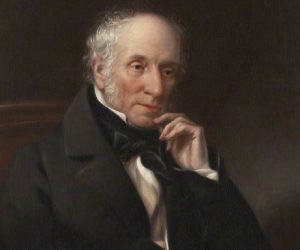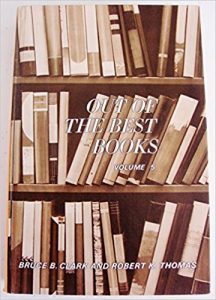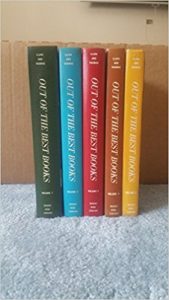This is the second post from my 2016 BYU English MA thesis titled “Out of the Best Books: Mormon Assimilation and Exceptionalism Through Secular Reading.” Part One can be read here. This thesis seeks to explore the relationship between Mormon assimilation, exceptionalism, and their endeavors in secular reading by analyzing Out of the Best Books (OOBB), a 1964–71 five-volume reading guide and reading program on secular reading established by the Mormon Church for its women’s organization, the Relief Society. The thesis can be read in its entirety here.
Part Two:
Discerning Mormon Truths in Secular Texts
In keeping with their proposed interpretive methods, the editors frequently reminded Mormon readers to maintain their sense of distinction as they embarked on secular reading, using their explicatory comments about Mormons’ unique worldview to persuade readers that only they could grasp the full spiritual implications of each author’s message. Thus, their program attempted to position Mormons as the most discerning readers of great literature by demonstrating how the most talented authors shared certain aspects of Mormon beliefs. For instance, in his introduction to several poems by Robert Browning, “probably the greatest English poet since Milton” (1:71), Clark explained that Browning “does firmly believe that God is in Heaven controlling the universe” and that “the potentiality of man in this life is great and the confidence with which he can look forward to live beyond death is equally great” (1:71).
Furthermore, in his explication of Browning’s “Johannes Agricola in Meditation,” a portrait of a self-righteous Protestant clergyman, Clark inferred that “Browning believed just as strongly as do members of the LDS Church that faith without works is dead and that an individual has the responsibility through an exercise of willpower to work out his own salvation” (1:237). Thus, by framing these classic texts as works focused on sentiments Mormons were particularly well equipped to recognize, Clark positioned OOBB participants as uniquely perceptive readers.

While Clark and Thomas offered many examples of authors expressing moral truths Mormons might easily recognize, they suggested that William Wordsworth, above all other writers, spoke with a voice Mormon readers are best equipped to hear. In his commentary on Wordsworth’s poetry, Clark suggested the poet discusses truths unique to Mormon theology, making Mormons the most insightful interpreters of his works. OOBB’s explication of Wordsworth’s poems thus offers the program’s most overt attempt to distinguish Mormon readers by establishing their superior vantage point for interpreting classic literature. In commenting on his “Intimations of Immortality,” Clark connected Wordsworth’s explorations of life before birth (latching onto his declarations that “our birth is but a sleep and a forgetting” and that we come “trailing clouds of glory” from “God, who is our home”) with “the unique Latter-day Saint doctrine of pre-existence, which extends immortality in both directions, not only forward into post-mortality following death and resurrection, but also backward into premortality before birth” (1:61). While Clark conceded that “all Christian churches recognize life after death and many Christian people have an inherent feeling that there is life before birth,” he insisted that “The Church of Jesus Christ of Latter-day Saints alone teaches as an official doctrine that we mortals existed as individual spirit children with God our Father and exercised our free agency for development in a pre-mortal state” (1:61).
Clark not only linked Wordsworth’s supposed visions of a pre-earth life and eternal family ties to Mormon doctrine, but he also suggested that Wordsworth may have been inspired by God directly, again implying that Mormon readers have a unique ability to trace literary truths’ divine origins. Clark asserted that the poet seemed to “speak with a voice of divine authority” (1:61) and connected him to Mormon prophet Joseph Smith. Clark acknowledged that “Wordsworth was not, of course, a Latter-day Saint and perhaps never heard of ‘Mormonism,’” yet he submitted that the poet “might very well have been an inspired forerunner of the Gospel” when he wrote the “Immortality” ode in 1805—“the very year of Joseph Smith’s birth” (1:61). It did not matter whether or not Wordsworth was privy to the origin of his message or that his work sometimes contradicted Mormon theology—Clark noted the poet’s early “strong Pantheistic leanings” (1:64). Clark still suggested that the best poets, of whom Wordsworth was his prime representative, unwittingly experienced and transcribed moments of divine inspiration that Mormons were best equipped to distill. Moreover, by encouraging readers to view secular texts as the products of divine inspiration, despite their non-Mormon authorship, Clark and Thomas proposed a means of reconciling Mormons’ obligation to remain separate from the world with their recognition of universal truths. By suggesting that secular texts contain wisdom directly from God that Mormons are best equipped to uncover, the editors offered a means by which OOBB readers could embrace truth outside their faith tradition yet still enjoy privileged access to it.
Acknowledging and Incorporating Outliers
Throughout the OOBB program, Clark and Thomas doggedly maintained that nearly any text—even those that might seem to challenge Mormon values—could be incorporated into Mormon readers’ narrative of truth. From the first volume, Clark and Thomas acknowledged the inevitability of these outliers or texts that departed from Mormon ideas of morality. Yet the editors argued that the majority of these seemingly subversive texts could still be embraced by Mormon readers if they simply viewed them as “negative examples” that heightened the importance of moral actions, allowing Mormons to retain their privileged access to truth while embracing secular literature.
For example, in Thomas’s introduction to literary criticism in the first volume’s opening chapter, Thomas acknowledged that readers would indeed encounter many texts that, at first glance, might seem to threaten their beliefs and values. He conceded that it was certainly “possible to object to Nathaniel Hawthorne’s The Scarlet Letter as a tale of adultery” (1:8). Yet he insisted that “to do so [would be] to miss Hawthorne’s real theme—the consequences of sin” (1:8). Thomas concluded his commentary on this example by warning readers of the “temptation to apply our standards without enough thought” and teaching that by reading Hester Prynne as a foil to the chaste Mormon woman, readers would be able to view the text as a “profoundly novel and uplifting story” (1:8).
While Clark and Thomas frequently described how authors self-consciously employ counter-examples of moral behavior as instructive devices, they also suggested that readers could impose this framework on nearly any text that seemed to resist Mormon values. Presumably, such an approach would permit Mormon women to remain comfortable reading secular literature in a way that reinforced their particular beliefs and unique access to truth, further emphasizing the broad range of texts Mormons might approach with their privileged interpretive lens. Thus, Clark and Thomas expanded Mormon readers’ opportunities to assimilate into mainstream literary culture by prescribing interpretive methods that converted all texts into moral tales Mormons could read without relinquishing their understanding of those truths that separated them from the rest of the world.
Additional Tensions
 While Clark and Thomas’s interpretive methods did in many respects help readers smoothly navigate assimilation and separation, the editors’ prescribed approach to classic literature was not without problems. They did present a fairly cohesive pattern of reading that assisted readers in locating unique Mormon truths in literature and distilling from that literature interpretations compatible with Mormon beliefs and values. But the editors also encountered areas in which their attempts to help Mormon readers assimilate while remaining somewhat separate were not entirely seamless. These areas include their efforts to incorporate several difficult outlier texts, embrace world literature, and address Mormon women—the program’s supposed primary audience who went consistently overlooked.
While Clark and Thomas’s interpretive methods did in many respects help readers smoothly navigate assimilation and separation, the editors’ prescribed approach to classic literature was not without problems. They did present a fairly cohesive pattern of reading that assisted readers in locating unique Mormon truths in literature and distilling from that literature interpretations compatible with Mormon beliefs and values. But the editors also encountered areas in which their attempts to help Mormon readers assimilate while remaining somewhat separate were not entirely seamless. These areas include their efforts to incorporate several difficult outlier texts, embrace world literature, and address Mormon women—the program’s supposed primary audience who went consistently overlooked.
Despite the editors’ faith in their inclusive approach to secular literature, the Correlation Reading Committee, the administrative body responsible for reviewing and approving all lesson curriculums for the Mormon Church, was less confident in the editors’ curating standards. Upon review, they rejected several selections they felt could never be interpreted as uplifting, including Shirley Jackson’s “The Lottery” and John Steinbeck’s “The Chrysanthemums.” Clark recorded his private frustrations about these rejections in his autobiography, but ultimately acquiesced and omitted the offending texts. However, the root of the disagreement—where OOBB should draw the line that defined what was and was not appropriate for Mormon readers—remained unresolved.
Though OOBB’s editors were remarkably liberal in their argument that nearly any text could be included in its canon, Clark and Thomas did imply that Mormons should avoid some texts altogether, signaling that their “open” canon had its limits. (Throughout the volumes, the editors spoke particularly unfavorably of contemporary literature and its “pessimism.”) Thus, OOBB presents a significant tension that Clark and Thomas did not resolve: when seeking truth outside the Mormon faith tradition, how do Mormons determine what they must reject and what they can safely embrace? Or in other words, how far beyond their borders can Mormons reach in their assimilative attempts without diluting their unique beliefs?
The editors’ treatment of their female audience and their exploration of world literature also introduced unanswered questions. Though OOBB was notably progressive in terms of its inclusion of literature by women and non-Western authors, it still largely failed at assisting Mormon readers in exploring cultural difference and attending to the specific needs and values of the program’s female readership. In terms of world literature, the editors’ principle focus remained on integrating these texts into a narrative of universal truths inspired by Mormonism, hindering any attempt to thoroughly explore the non-Western cultures they set out to examine. Thus, OOBB’s treatment of non-Western literature raises the question of how Mormons might truly understand and unite with other cultures when solely focused on a narrative of truth defined by Mormon values.
And finally, just as OOBB’s emphasis on a singular narrative of truth in world literature made it difficult for participants to engage with diverse cultural ideas and practices beyond Mormonism, this focus had a similarly flattening effect on the program participants themselves. Despite some notable efforts to tailor OOBB to their female audience through including texts by women writers, for the most part, Clark and Thomas failed on this front. Throughout their commentary on over two hundred literary passages, the editors specifically discussed “womanly attributes” (their stated focus) only twenty times. While they do on rare occasion mention women, usually connecting the trait of a particular female character to attributes of “good” wives or mothers, the editors used male pronouns far more frequently than female pronouns when referring to their audience, and they mentioned universal roles far more often than gendered ones. For instance, parenthood and marriage were considered far more regularly than motherhood and wifehood. Throughout the majority of the volumes, Clark and Thomas reflected on how general Mormon readers might develop more humility, faith, and honesty and become more cultured and aware of the world around them, rather than how Mormon women in particular might cultivate these traits. As with their reading of world literature, Clark and Thomas’s attempt to group women into a universal narrative made fully recognizing any beliefs or experiences that departed from this narrative difficult.
Because Clark and Thomas were not successful in guiding Mormon readers through a pattern of secular reading that eliminated tension entirely, an OOBB reader was faced with many complex questions, such as how to determine which texts to embrace and which to avoid as well as how to incorporate non-Western literature and include female readers in all their multifaceted diversity. While these specific issues are, in large part, unique to OOBB and cannot be extrapolated to every situation involving Mormon assimilation and separation, their presence encourages us to examine these situations in more detail, looking for the many and complex ways Mormons negotiate their cultural identity.
Lauren grew up in Seattle, Washington, and earned a master’s degree in American literature at BYU last year. She is currently a writer and content manger for DeseretNews.com in Salt Lake City, but continues to have an interest in contemporary American literature and Mormon literature.


These posts have been really interesting, Lauren. I’m especially intrigued by your framing of assimilation and exceptionalism as that’s a tension that’s fueled a lot of my work.
Your observation of the flattening effect reminds me of how the field of comparative literature started out after WWII. The discipline’s proponents saw its purpose similarly–of finding commonalities across cultures, especially, of course, universal experiences (and maybe even truths) that were supportive of a pro-democratic worldview.
Thank you, and that’s a very interesting connection. I can definitely see the similarities.